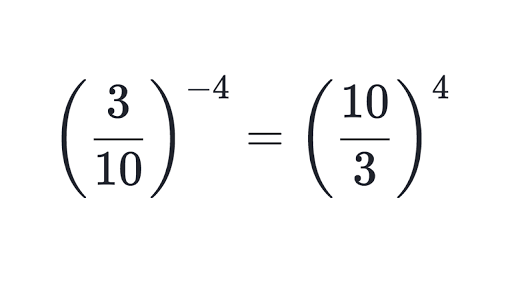Can The Base Of An Exponent Be Negative
Thus an exponential function with a negative base such as isnt much of a function at all it is not continuous since it can only be evaluated at very specific x-values. The range of any.
 Exponents Anchor Chart Fifth Grade Math Classroom Anchor Charts Exponents Anchor Chart
Exponents Anchor Chart Fifth Grade Math Classroom Anchor Charts Exponents Anchor Chart
Exponential function cannot have a base of 0 1 or a negative value.

Can the base of an exponent be negative. Negative base will become negative if the power is odd. For example and so on. Bring it up to the numerator while making the exponent positive.
To simpify expressions we can. If there are parentheses around the negative base the power applies to the entire equation -- including the negative sign. Negative Base Powers Powers can have a minus sign in the base but be careful because you have to differentiate 2 cases.
What Im going to show you now is a REALLY common place to mess up in Algebra. We know that the minus sign is affected by the exponent because the number or variable and the minus sign. 1 The minus sign is affected by the exponent.
The first place that negative numbers can appear is in the base. This time the base with a negative exponent is found in the denominator. The general formula of this rule is.
The logarithmic function is not defined for zero or negative numbers. So a logarithm with a negative base like would also only work for very specific arguments due to its connection to the non-continuous and such a logarithmic function would also not be continuous. A negative fractional exponent works just like an ordinary negative exponent.
When working with negative exponents we are working with numbers that are less than 1 whole. The second convention allows the base to be less than zero as well but the exponent needs to have an odd number in the denominator. For integer values of x our function is well defined.
They are decimals or fractions. Furthermore the first answer states. So pay extra close attention.
Logarithmic functions typically appear in the form. First we switch the numerator and the denominator of the base number and then we apply the positive exponent. Are these the same.
A negative exponent just means that the base is on the wrong side of the fraction line so you need to flip the base to the other side. When we do problems on positive exponents with negative bases it is important to know the. Where the base.
The number n is called the exponent and the expression is known formally as exponentiation of b by n or the exponential of n with base bIt is more commonly expressed as the nth power of b b to the nth power or b to the power nFor example the fourth power of 10 is 10000 because 10 4 10 10 10 10 10000The term power strictly refers to the entire expression. Positive Exponents with Negative Bases. In Real Analysis the base of an exponential is defined for all positive real values excluding simply equals for all.
The law of negative exponents states that when a number is raised to a negative exponent we divide 1 by the base raised to a positive exponent. If the base is negative and the exponent is an even number the final product will always be a positive number. Mathematical Focus 6 Logarithmic functions which are directly related to exponential functions and commonly taught at the same time as them also display similar properties.
This can be fixed by moving it to the denominator and switching the sign of the exponent to positive using the negative rule of exponent. Whenever we have a negative number as exponent and we need to make it as positive we have to flip the base that is write the reciprocal of the base and change the negative exponent as positive exponent. Simplify the exponential expression.
The symbol sqrtna is defined for negative values of a so long as n is odd. Logarithms are the inverse of the exponential function for a Any exponent of a positive base must be positive. Since we cannot take the even root of a negative number we cannot take a negative number to a fractional power if the denominator of the exponent is even.
A -m 1a m and ab. If the base is negative and the exponent is an odd number the final product will always be a negative number. For instance x2 pronounced as ecks to the minus two just means x2 but underneath as in frac 1 x2 x21.
Has the same properties. To answer the question of why the base of an exponential function cannot be negative consider the function.
Read more »


































